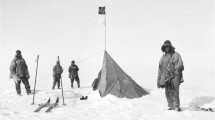Abstract
Over the past several decades a heated debate and gradual Kuhnian-like paradigm shift has been taking place in American archaeology that relates to the initial peopling of the western hemisphere. The central role of the Monte Verde archaeological site in Chile in the debate and paradigm change and the obstacles to its eventual acceptance are discussed. Monte Verde is a unique site that radiocarbon dated at least 1500 years earlier than expected and exhibited a wide array of organic cultural materials that revealed extraordinary details of the economy, technology and lifestyle of early Americans in southern South America during the late Pleistocene era. The uniqueness of the site and its age made it controversial and prolonged its final acceptance.
Access this chapter
Tax calculation will be finalised at checkout
Purchases are for personal use only
Similar content being viewed by others
References
Adovasio, J. M., & Pedler, D. (2016). Strangers in a new land: What archaeology reveals about the first Americans. Firefly Publishers.
Anonymous. (2012). The rancorous debate over when people first arrived in America has not helped science. Nature, 485, 6. https://doi.org/10.1038/485006b
Barber, B. (1961). Resistance by scientists to scientific discovery. Science, 134, 596–602.
Barnes, S. B. (1969). Paradigms–Scientific and social. Man, 4, 94–102.
Braje, T., Erlandson, J. M., Rick, T. C., Davis, L., Dillehay, T. D., Fedje, D. W., Froese, D., Gusick, A., Mackie, Q., McLaren, D., Pitblado, B., Raff, J., Reeder-Myers, R., & Waters, M. R. (2018). Fladmark + 40: What have we learned about a potential Pacific coast peopling of the Americas? American Antiquity. https://doi.org/10.1017/aaq.2019.80
Dillehay, T. D. (1981). Early man in the south-Central Andes: Monte Verde. In Union Internacional de Ciencias Prehistoricas y Protohistoricas, X Congreso XII (pp. 58–61). Mexico City.
Dillehay, T. D. (1989). Monte Verde: A Late Pleistocene Settlement in Chile. Volume I: The Paleo-environment and Site Context. Smithsonian Institution Press.
Dillehay, T. D. (1997a). The Battle of Monte Verde. The Sciences, 37, 28–33.
Dillehay, T. D. (1997b). Monte Verde: A Late Pleistocene Settlement in Chile: Volume 2: The archaeological context and interpretation. Smithsonian Institution Press.
Dillehay, T. D. (2023). Correction for a Monte Verde II radiocarbon date. PaleoAmerica. https://doi.org/10.1080/20555563.2023.2236889
Dillehay, T. D., Ocampo, C., Saavedra, J., Sawakuchi, A. O., Vega, R. M., Pino, M., Collins, M. B., Scott-Cummings, L., Arregui, I., Villagran, S. X., Hartmann, G. A., Mella, M., González, A., & Dix, G. (2015). New archaeological evidence for an early human presence at Monte Verde, Chile. PLOS One. https://doi.org/10.1371/journal.pone.0141923
Dillehay, T.D., Ocampo, C., Saavedra, J., Pino, M., Scott-Cummings, L., Kovácik, P., Silva, C., , R. Alvar (2019). New excavations at the late Pleistocene and early Holocene site of Chinchihuapi I (Monte Verde), Chile. Quaternary Research 92: 70–80.
Goebel, T. (2015). Expanding the dialog on the peopling of the Americas. PaleoAmerica, 1, 295–296.
Kirby, M. W. (2007). Paradigm change in operations research: Thirty years of debate. Operations Research, 55, 1–13.
Kuhn, T. S. (1970). The structure of scientific revolutions (2nd ed.). University of Chicago Press.
Marker, M. (2019). Indigenous knowledges, universities, and alluvial zones of paradigm change. Discourse: Studies in the Cultural Politics of Education, 4, 500–513.
Meltzer, D. (2021). First People’s in a New World. Cambridge University Press.
Mitroff, I. I. (1974). The subjective side of science: A philosophical inquiry into the psychology of the Apollo moon scientists. Elsevier.
Moran, G. (1998). Silencing scientists and scholars in other fields: Power, paradigm controls, peer review, and scholarly communication. Ablex.
Potter, B. A., Beaudoin, A. B., Haynes, C. V., Holliday, V. T., Holmes, C. E., Ives, J. W., Kelly, R., Llamas, B., Malhi, R., Miller, S., & Surovell, T. (2018). Current evidence allows multiple models for the peopling of the Americas. Science Advances, 4. https://doi.org/10.1126/sciadv.aat54
Acknowledgements
I thank the many colleagues, especially Mario Pino, the project geologist, who worked with me for many years at Monte Verde. I also am grateful to those individuals, such as Jose Saavedra and the late Carlos Ocampo, who also worked many field seasons at the site, and Eduardo Alvar, who have continued to logistically support the research and made great efforts to establish the Museo Monte Verde in Puerto Montt. Local residents of Monte Verde have been very generous and supportive of our work, and we thank them for their friendship and cooperation. Lastly, I also thank the institutions and individuals that supported the research at the site: the Universidad Austral de Chile, the University of Kentucky, reluctantly the National Geographic Society, the National Science Foundation, the Guggenheim Foundation, the Kohler Foundation, Vanderbilt University, the Rebecca Webb Wilson family, the Consejo de Monumentos Nacionales of Chile, and several anonymous private donors.
Author information
Authors and Affiliations
Corresponding author
Editor information
Editors and Affiliations
Rights and permissions
Copyright information
© 2024 The Author(s), under exclusive license to Springer Nature Switzerland AG
About this chapter
Cite this chapter
Dillehay, T.D. (2024). Frontline Involvement in a Paradigm Change: Archaeology of the First Americans and Monte Verde. In: Brunn, S.D. (eds) Geography of Time, Place, Movement and Networks, Volume 1. Springer, Cham. https://doi.org/10.1007/978-3-031-58021-5_3
Download citation
DOI: https://doi.org/10.1007/978-3-031-58021-5_3
Published:
Publisher Name: Springer, Cham
Print ISBN: 978-3-031-58020-8
Online ISBN: 978-3-031-58021-5
eBook Packages: Social SciencesSocial Sciences (R0)




